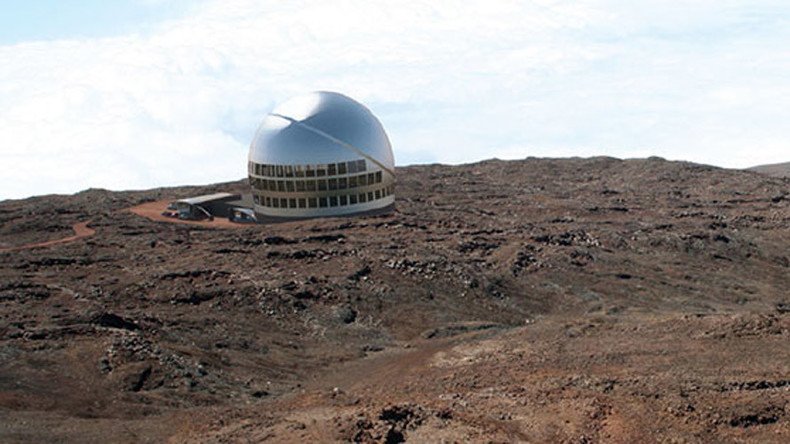Giant telescope slated for Hawaii could head to Canary Isles over indigenous protest

A giant telescope that could show "the earliest years of the universe" was slated for construction on top of a dormant Hawaiian volcano. But Native Hawaiians consider the mountain a sacred site and argue it has more value than a telescope for astronomers to look back in time.
Scientists now say the $1.4 billion telescope could end up being constructed on the Canary Isles off North African coast.
“TMT on Mauna Kea: Where Science, Culture & Community Collide” by @ChiaraShakirahttps://t.co/x50qomDyLF
— Carol Brandt (@STEMethnographr) August 11, 2016
The Thirty Meter Telescope (TMT), with a primary mirror measuring 183 feet (30 meters), once built would have 13 times the resolution of the Hubble Telescope and would enable scientists to see “into the earliest years of the universe.”
“TMT will enable astronomers to study objects in our own solar system and stars throughout our Milky Way and its neighboring galaxies, and forming galaxies at the very edge of the observable Universe, near the beginning of time,” according to the project’s website.
Canary Islands Are Alternate Site for Planned Mauna Kea Telescope https://t.co/5ULX13SblN
— Dunlap Observatory (@Dunlap_Obs) November 1, 2016
Telescope officials said Mauna Kea was the best location in the world for astronomy because its 14,000 high summit provides a clear view of the sky for 300 days a year, with little air and pollution.
Opponents argued the project will desecrate land held sacred by Native Hawaiians, and there are already too many telescopes on Mauna Kea.
“I have always supported astronomy…however, I do not believe it is of so much importance that it should be allowed to overtake and destroy everything else in its wake,” Kealoha Pisciotta, president of Mauna Kea Anaina Hou (MKAH) said on her blog. “I am for protecting the cultural and natural resources of Mauna Kea, which unlike astronomy facilities, are actually threatened. Large scale astronomy is being conducted at over 93 sites around the world, but here on Mauna Kea many of the plant and animal species can only be found on Mauna Kea.”
Hearings began on October 20 for the second time after protests disrupted the groundbreaking and Hawaiian blessing ceremony at the site two years ago.
Leinaala Sleightholm cross examines UH Hilo Witness Perry White re:… https://t.co/RyfqIr41Vbhttps://t.co/SAgGuX9xLR
— Sacred Mauna Kea (@sacredmaunakea) October 25, 2016
In 2009, the telescope’s board of directors held public meetings before selecting Mauna Kea in Hawaii as the preferred site. Two years later, opponents began a contested–case hearing before the state land board approved a permit to build on conservation land. The hearings were held, and the permit was upheld.
ARTICLE: The first man has been arrested when protests at Mauna Kea continued this morning. http://t.co/LajNukYgkApic.twitter.com/Z0c3n9FnIh
— J0hn B0ok (@thisisjohnbook) June 24, 2015
Construction was stopped in April 2015 after 31 protesters were arrested for blocking the work. A second attempt to re-start construction a few months later ended with more arrests and crews retreating when they encountered large boulders on the road. Opponents sued and the state supreme court revoked the permit, ruling the land board’s approval process was flawed. The application had to be redone and required a new hearing.
UH details safety, cultural concerns atop Mauna Kea during TMT protests http://t.co/7Gf2tv4Trd#808newspic.twitter.com/SNNx49Cbmt
— khon2 News (@KHONnews) July 10, 2015
Pisciotta said what is not discussed is the quality of knowledge acquired from astronomy and questioned how it benefits mankind.
“For example, when you see on the front page of the newspaper KECK Observatory discovers a new black hole so many light years away? The question is what does information mean for people, what does it do for the people really? From a science perspective it means we discovered something we believe is a black hole event that may have existed millions of years ago and may not exist today. So I would have to say it’s a bit much to claim all of the people of Hawai`i will somehow benefit directly from these kinds of discoveries,” she said.
“It is not solving the cure for hunger, cancer or HIV, protecting our biodiversity by protecting rare, threatened or endangered species, providing people with clean water, reducing our energy consumption or inventing new forms of energy,” she added.
Lie or truth? The Thirty Meter Telescope (TMT) will "be the last built on Mauna Kea". https://t.co/EQAsDSiUGkpic.twitter.com/PnGTR9Nwjq
— World Travel (@worldtravel2day) November 26, 2015
A group of universities in California and Canada plan to build the telescope with partners from China, India and Japan. The marketing materials said the telescope’s construction would create 300 jobs and 140 staff would be hired when the telescope was operational, generating $26 million annually in observatory operations.
TMT Reaffirms Hopes for Mauna Kea, Despite Canary Islands Viewing https://t.co/UgBCfejC8opic.twitter.com/2VXpJCuVy8
— Big Island Now (@BigIslandNow) March 23, 2016
Earlier this year, TMT telescope officials began looking for alternative sites in the case the telescope can’t be built in Hawaii.
On Monday, they issued a statement saying, "After careful deliberation, the Board of Governors has identified Observatorio del Roque de los Muchachos (ORM) on La Palma in the Canary Islands, Spain as the primary alternative to Hawaii.”
ORM is on the edge of the Caldera de Taburiente National Park, about 7,800 feet above sea level.
Telescope officials also considered high mountains in Chile, China, India and Mexico, but they said Mauna Kea “was their preferred choice.”
"I'm glad they're looking at alternative sites," Pisciotta said during a break in the hearings, according to the Associated Press. "I have to say if they do go with the alternative site, I hope they don't do there what they're doing to Native Hawaiians and the people of Hawaii."












